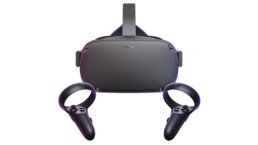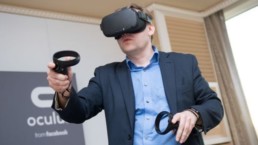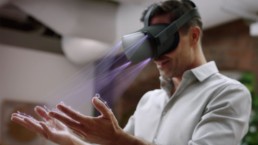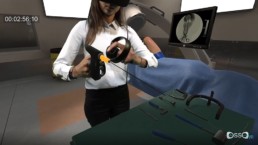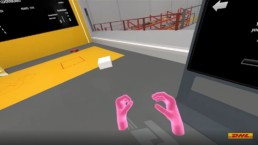15 November 2019
The Oculus Quest, the hard-hitting autonomous VR headset
Facebook’s Oculus has hit hard in the world of VR headsets with the recent launch of a completely wireless and mobile headset, the Oculus Quest. This headset is already establishing itself as an essential of the market, capable of appealing to amateurs and professionals alike. While Facebook does not communicate on the exact number of copies sold, we now know that the Quest made $5 million in sales of content in the first days of its marketing.
We were able to test this newcomer, is it the best VR solution at the moment?
First observation when we find ourselves in front of the Oculus Quest: the very neat finish. Oculus has chosen to cover its headset with a thick fabric, pleasant to the sight and to the touch. The ergonomics of the headset are identical to that of Oculus Rift, the attachment system for the head works well and the materials chosen seem sturdy.
Oculus Quest does not need neither external sensor nor PC to work, we do not get tangled in the cables. It comes with Oculus Touch controllers that can simulate hands in virtual space. This headset is affordable (less than 500 euros) and easy to use. The grip is fast and intuitive. The weight of 571g is not really felt, to see if it is always the case during sessions of several hours. Technically speaking, Facebook’s headset makes possible to move freely in one maximum space of 5 m2 . It has 2 integrated speakers with a volume control directly on the headphones, 2 headphone jacks are also present. The autonomy of use is 3 hours maximum, less if you use features like screen sharing. Note that it is possible to use it plugged into the mains.
The Quest does not allow to display as many 3D models as a wired headset, in fact, a stand-alone headset cannot have the same power as a headset connected to a PC. However for 90% of uses, the power of the Quest will be sufficient. The quality of the screens is very good, the grid effect is certainly more pronounced than on more powerful models, but the overall rendering of the headset is very satisfactory. The resolution is 1440 x 1600 pixels per eye.
From a user experience point of view, the Quest is simple and easy to configure and use. This headset has been designed to democratize and make VR accessible to the greatest number and it is totally successful for Oculus. In less than a minute you have configured your headset which is ready to use, this speed of use is to be noticed. Being able to quickly change the area of use is an asset for users, especially since the headset remembers the previously defined areas.
The Quest is therefore a full headset who can count on many advantages :
- A pleasant ergonomics and a good finish,
- A complete VR experience thanks to the freedom of movement,
- Its mobility : it does not require a PC to operate,
- Very high optics quality technology,
- An unbeatable handling.
The Quest is a relevant choice for a use :
- In training: To put the learner in a situation with realistic scenarios,
- In marketing: To immerse customers in its universe or through its product catalog,
- In design: To experiment and validate the design of its products.
Finally, the Oculus Quest is a scalable device, an update will be launched in early 2020 allowing the headset to directly recognize the user’s hands. The uses will be even more extensive with the possibility to perform precise technical gestures and interact with applications without a controller.
If certain uses require additional power, a cable, the Oculus Link will connect the headset to a PC to benefit from its computing power, we are thinking in particular of the display of large volumes of 3D data .
